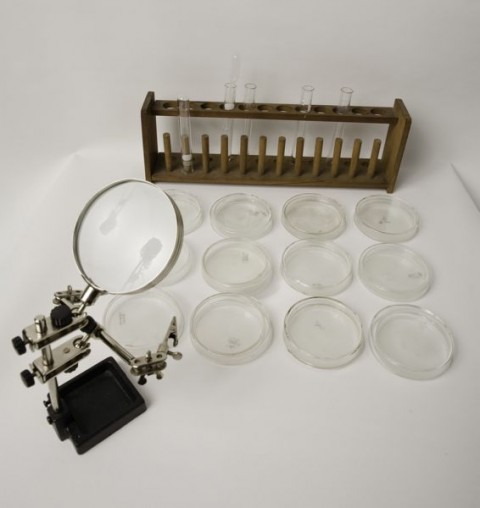


Lim Kok Boon, 'Meal Series', 2000 - ongoing, 35mm slides, Image Courtesy of the artist
Two different exhibitions opened on the same evening and venue early August 2009: The Air Conditioned Recession: A Singapore Survey organised by Valentine Willie Fine Art, and Curating Lab: 100 Objects (Remixed) organised by the National University of Singapore (NUS) Museum.
Arriving at the siamese-twin opening (conjoined by a reception spread), I was asked a question that started this whole train of thought: “Isn’t is great to see that there are so many great Singaporean works?” or something to that effect. This question got me thinking about what my response was to be, perhaps an expected approving and sagely nod to our growing ‘creative industries’ and all the machinations and efforts that underpin these developments. Instead I started to think about my role there, as part of the public that was to witness it, to approve it, a public that had been imagined for these exhibitions, the recipient of this visual largesse – 2 openings, 34 artists, 49 artworks, 3 performances, for those who are counting.
The public as exemplar KPI (key performance indicator – the rather dry metrics that claim to measure success and gets touted as justification for monies spent) puts certain pressures on the exhibitionary process. It is the addressing of such an imagined public that sees the co-optation of these exhibitions as partner programmes of the Singapore Art Show, a visual fiesta that is a counterweight to the National Arts Council’s other prodigious offspring the Singapore Biennale, likewise twin events so that the centrifugal forces (of the finely-tuned art world or one’s visual experience) are balanced and do not get disrupted by hasty one-sided loading… Remember to laugh, lest we take things too seriously and indiscriminately lionise all things starting with ‘g’ – like ‘gardening’ (lack of private land and not being allowed to ‘garden’ in public land), ‘garang (karang) guni’ (how things get recycled in a disposable society) and ‘gaffer tape’ (things that make you stop talk-…).

Lim Kok Boon, 'Meal Series', 2000 - ongoing, 35mm slides, Image Courtesy of the artist
In reality, the attribution of success is of a more complex equation that not only counts warm bodies but demands a certain interaction with these warm bodies. “What we would now call curating, in effect this organising of displays and publics, (has) constitutive effects on its subjects and objects alike. The collection and display of specific objects and artefacts according to certain curatorial techniques, (represents) not only the writing of specific colonial and national histories, but also crucially, the circulation of certain values and ideals.”1
Curating Lab, as exhibition not laboratory, arguably (from an outsider’s point of view and a simplification at that) is premised on the question: what makes an exhibition ‘Singaporean’ or what can a ‘Singaporean’ exhibition tell, and that curation ‘experiments’ on possible answers, answers that are formulated here from a series of 100 objects which have been marked out as ‘Singaporean’, which then makes it a somewhat recursive exercise. Here we find a meta-exhibition in a sense in this laboratory for intentions yet to be realised, with the assumption that the deconstruction or reverse engineering of an exhibition can reveal the ‘heart’ of an exhibition, from which other forms of criticality can be construed. Yet from experience exhibitions are determined by conditions often including those beyond the control of curators. As Ahmad Mashadi one of the curators notes, reflexivity well does the institutional head in; where the institution tautologically institutionalises whatever passes through its doors, attempts to resist become contradictory. Reconciliation however may be found in the fragmentation of the notion of the institution, in a postmarxian destabilisation of identity, and in its place a process of identification where “this range of voices would contain a degree of self-reflexivity, a sense of irony and a sense of ambivalence.”2 As the exhibition attempts to interrogate ‘the idea of history and culture as sites of contestation’, introducing into the mix art, media, film, architecture and text in its ‘sampled’ exhibition of pre-qualified works, the possibility that is not raised however is if the logical end of the archive (that is promised in the publication to come) might in fact be the absence of a hierarchy-forming exhibition. Now that would have been resistance.

Tan Seow Wei, 'The Petri Dish Series', 2007, Mixed media, Variable sizes
Moving then from a discursivity produced by institutions and curatorial framing, the second exhibition presents works about a discursivity produced by artists through their works. The Air Conditioned Recession: A Singapore Survey that is organised by a ‘commercial’ gallery, albeit one that has a track record of being quite edgy (oft used in enterprise culture parlance to refer to the contemporary), reveals a certain ironic turn as well. The playful title synthesising globalisation’s getting ahead of itself economically with the denial of tropical weather conditions references Cherian George’s text The Air Conditioned Nation: Essays on the politics of comfort and control (2000) that reflects upon the reigning government’s political style. Juxtaposed with the state of the arts, the exhibition raises questions on engagements with limitations and restrictions, at the same time in its sensitive presentation it is ironically also demonstrative of how democratic capitalism (amongst other things) subsumes resistance. The exhibition in a way proves itself more contemporary than its casual title suggests, tackling the role of the exhibition in a politics of representation – in both the sense of questioning the validity of the perceptions of the Singaporean condition, and the engagements with and representations of these perceptions in Singapore art.
At this point one might wonder the way the text has been going if artworks were actually involved in these exhibitions, and I assure you that there were, made all the more interesting for their inclusions and exclusions while signalling comprehensiveness through the presentation of a range of genres, media and generation, from acknowledging established artists with Tang Da Wu’s Chin Wa Gave Birth to a Bridge (2009) (with possibly the best artwork statement “A Bridge’s Birthday”) and a gallery space away Amanda Heng’s Let’s Chat (1996-2000, re-enacted/enacted again), introducing emerging artists like Tan Seow Wei’s The Petri Dish Series (2007), to percipient works such as John Low’s Ghost Stories (2002) and the meals that contribute to Lim Kok Boon’s well-being.

Tan Seow Wei, 'The Petri Dish Series', 2007, Mixed media, Variable sizes
The imagined public for these exhibitions (propelled into the public’s imagination via a powerful administrative publicity machinery) extends beyond an art audience (unlike the imagined public for this wayward text of presumably those who can tell the difference between an art exhibition and an art expo, an art fair and an art happening, and know on which end to sit a student art exhibition) to a non-art population (though it is a bit of a misnomer since once they step into the galleries they are technically art audiences). As the overarching event drives this imagined public to these presumed pedagogical sites, the question arises what would these works duly congregated then speak to the individual who walks in? Well, you’ll just have to see for yourself won’t you and make up your own mind.
(JY)
1 Simon Sheikh, Constitutive Effects: The techniques of the Curator, in Curating Subjects, edited by Paul O’Neill, published by De Appel (Amsterdam), 2007, London
2 Ahmad Mashadi in 100 Objects: A Conversation Between Curators Heman Chong, Lim Qinyi and Ahmad Mashadi, in exhibition brochure, 2009
No comments yet.
Sorry, the comment form is closed at this time.